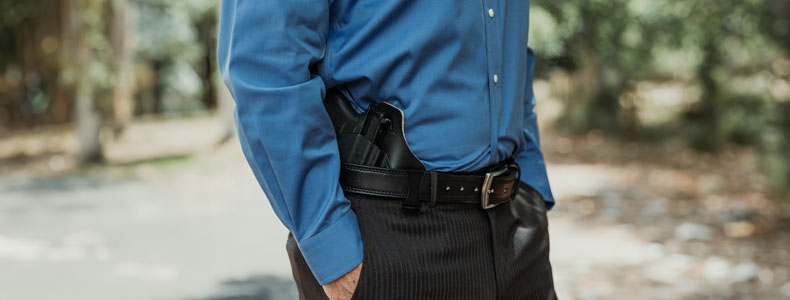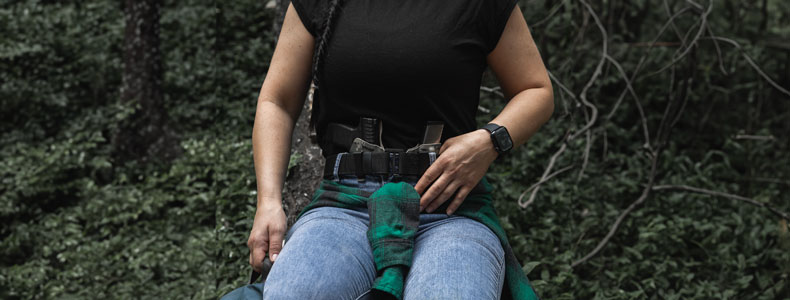How To Wear An IWB Holster
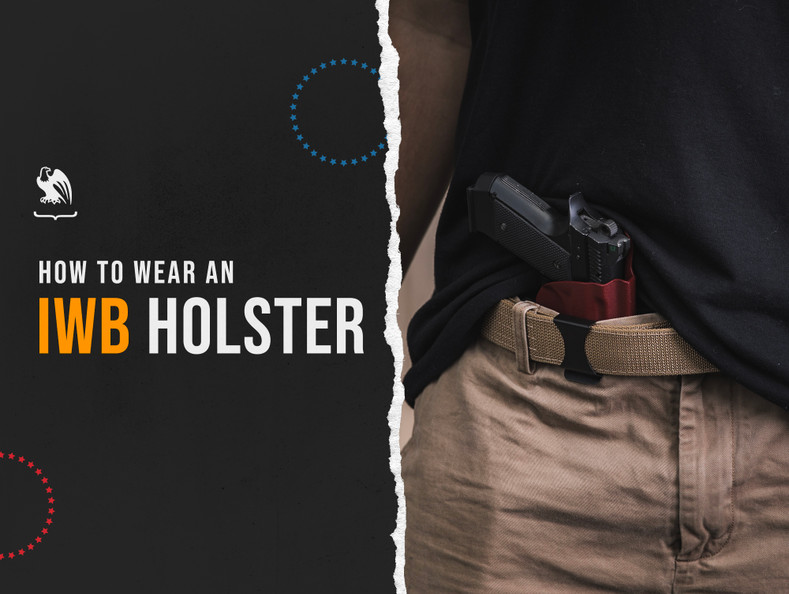
Inside the waistband or “IWB” holsters are one of the most popular choices for concealed carry, and rightfully so. Inside the waistband holsters are carried inside your waistband (obviously) between your body and your clothes, making for a comfortable and low-profile carry setup when worn correctly.
There are numerous factors to consider when it comes to how and where to wear an IWB holster. The best IWB carry setup for you will depend on a variety of factors, including your body type, daily activities, and personal preferences.
Let’s take a look at the different ways you can wear an inside the waistband holster along with some tips and tricks for a better concealed carry experience.
Products Mentioned In This Article
What Is An IWB Holster?
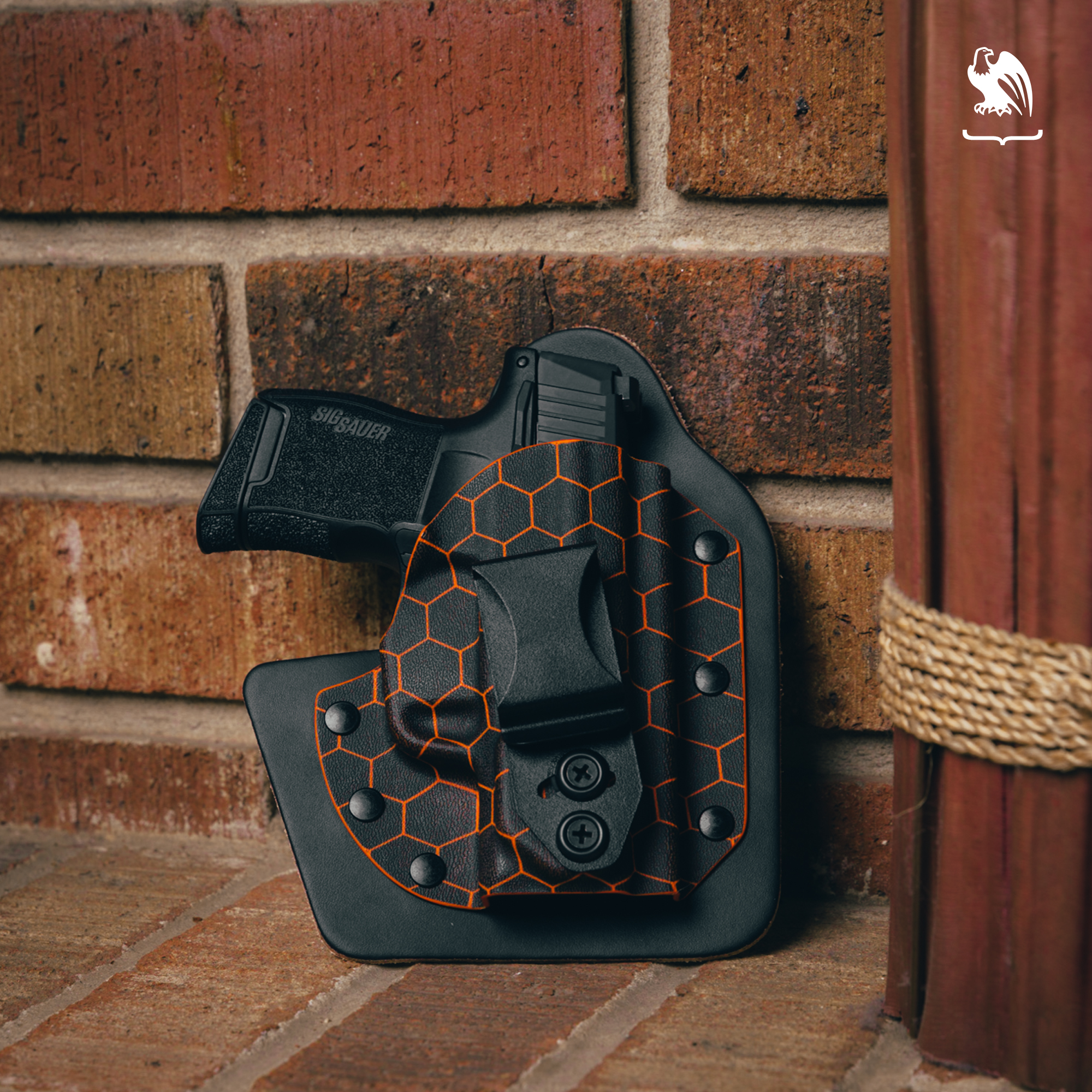
IWB holsters are hands down the most popular method of concealed carry. A quality inside the waistband holster is known for being arguably the most comfortable and low-profile option available.
This kind of holster is worn, you guessed it, inside of your waistband between your clothing and your skin. The holster has clips that are attached to your gun belt while the pistol and holster are both nicely concealed under your clothing.
Inside the waistband holsters are also one of the most versatile concealed carry options. A quality one will easily hide underneath nearly any type of clothing with virtually no printing.
Some IWB holsters are even “tuckable” meaning that they are designed to be concealed under a tucked-in shirt. Our LightTuck™, RapidTuck™, and ComfortTuck™ holsters are all designed with our patented Rock Solid Spring Steel Belt Clip, which is designed to be ultra tuckable and concealable.
Are IWB Holsters Comfortable?
Inside the waistband holsters are one of the most comfortable carry options available so long as you choose a system that works for your body and lifestyle.
A multitude of factors can influence how comfortable a holster is. The position you wear it in, the material of the holster, your body type, your day-to-day activities, the clothing you wear, and even how much time you spend driving every day will impact your comfort level while carrying IWB.
Leather, Kydex, and nylon are a few of the material options available when it comes to concealed carry holsters. Kydex IWB holsters are a popular choice thanks to their thin profile and custom, secure fit for your gun. The security that comes with carrying a quality Kydex IWB holster, along with its thin, concealable design, makes it one of the most comfortable IWB choices.
Tight clothing will also impact whether these holsters are comfortable. Tight-fitting pants may jam your gun into the side of your body, which is obviously uncomfortable, especially for long periods.
A quality gun belt can also help make IWB carry more comfortable. They provide the stiffness necessary to keep your firearm in place all day, preventing your pistol from sagging or sliding into an uncomfortable position throughout the day.
Finding the right carry position is another essential part of a comfortable IWB experience. Check out our article here to learn how to find the most comfortable carry position for you based on your body type.
Investing in an inside the waistband holster with adjustable ride height, cant, and retention will also make carrying IWB significantly more comfortable. Ride height dictates how high or low the holster sits on your waistband, while an adjustable cant allows you to choose the angle at which your weapon sits. Both options allow you to adjust your holster to a comfortable position for your carry needs.
The Vedder LightTuck™ Kydex IWB holster features both an adjustable -30 to +30 degree cant and an adjustable ride height. Most comfortable IWB holsters come with these features.
How To Wear An IWB Holster
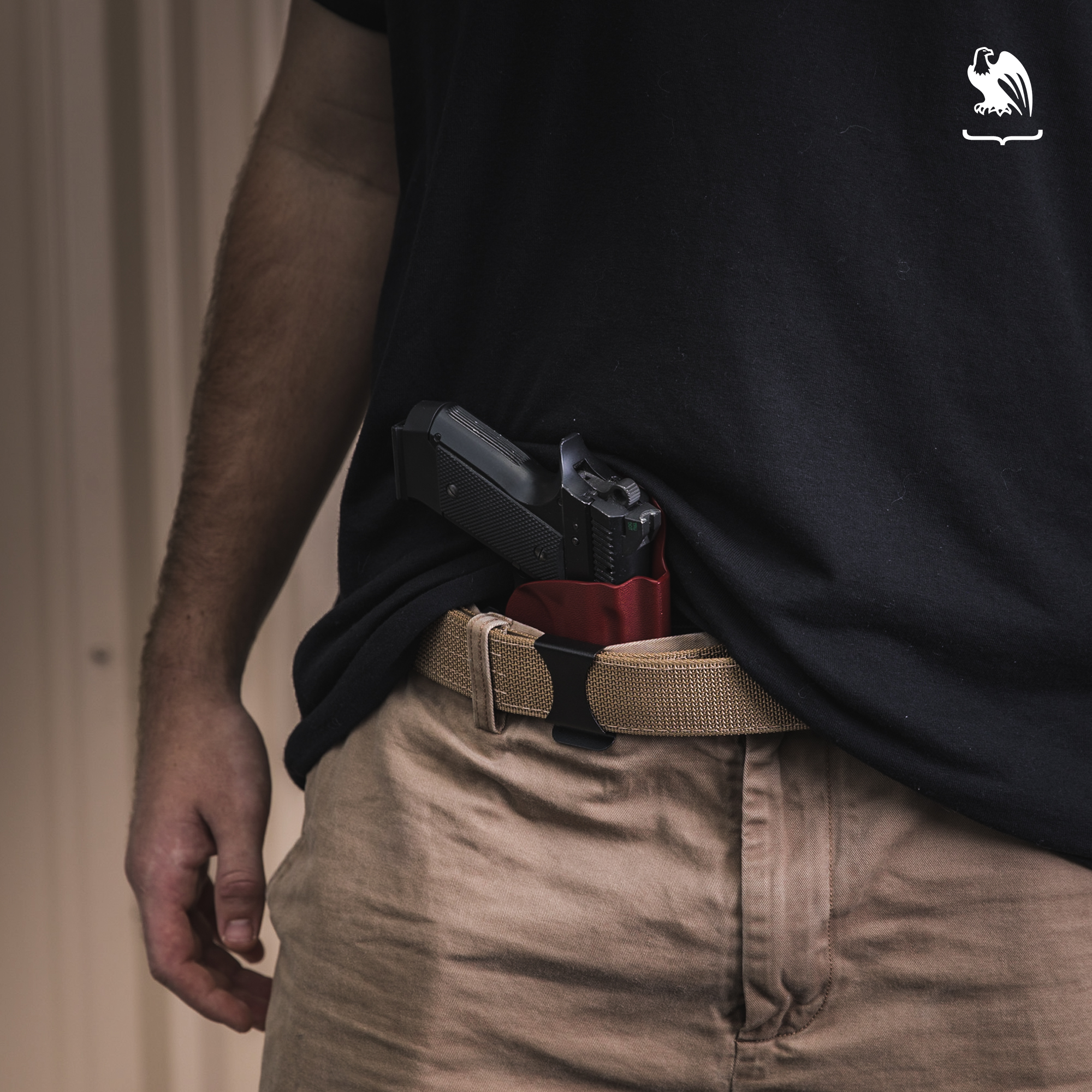
Putting an inside the waistband holster on for the first time can be tricky. It may take you some time to get comfortable with the process, and that’s okay! For safety reasons and for the sake of simplicity, we recommend putting your holster on without your gun in it at first. Once you get more comfortable with the technique, you can start putting your holster on with the weapon already inside.
Here’s a step by step for putting your holster on:
- Don’t try to just jam your holster into your pants. Start by unhooking your belt and loosening it up a bit. Undo your pant button and unzip your pants a little if necessary.
- Slide your holster under your waistband and into your concealed carry position of choice. (Hint: You can hold your pants up with your left hand while your right hand positions the holster.)
- Fasten the holster clips over your carry belt.
- Zip up your pants and buckle your belt. (Please don’t forget this VERY important step. Nobody wants to see your fly open!)
- Insert your gun if you haven’t done so already. Do a quick check to ensure everything is securely in place and nicely concealed, then get on your way!
To remove your IWB holster at the end of the day, follow the same steps except in reverse (duh).
IWB Carry Positions
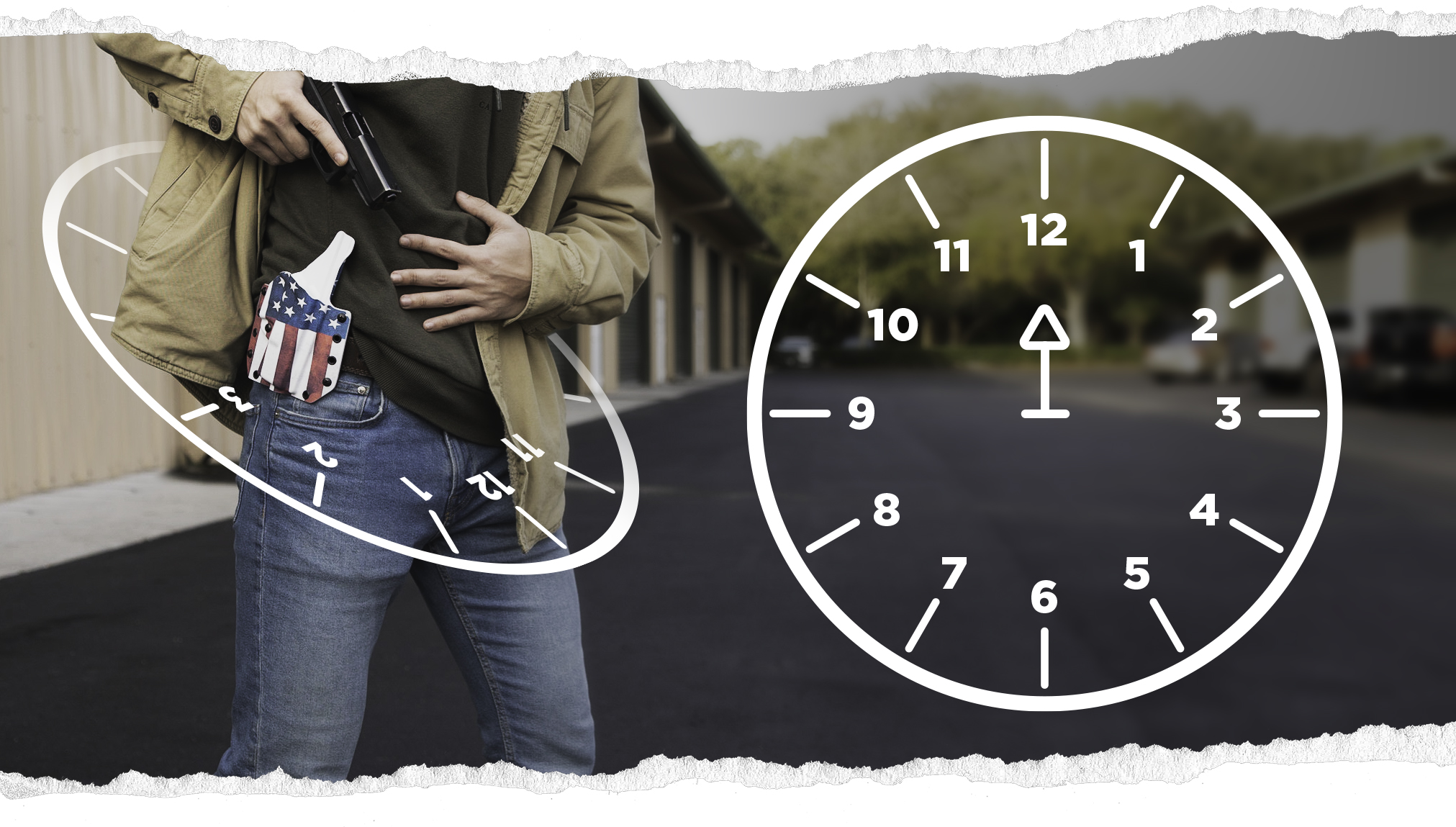
There are many different ways to carry IWB. The position that works best for you will depend on your body type, clothing choices, and daily activities. For example, a position that works well for an accountant who sits most of the day may not necessarily be the best choice for an electrician who works on his feet.
When we talk about IWB carry positions, we often use the hours on a clock to refer to each spot. Since the human body is somewhat round (this is true for some of us more than others…), it makes it easy to understand the positions.
So, imagine you’re standing on the face of a clock. Your naval will be pointing to 12 o’clock, the small of your back will be facing 6 o’clock, and your hips will be 3 and 9 o’clock.
In theory, you can carry at any point on your body depending on what is most comfortable. That could mean you carry at 3:30 o’clock or even 2:45 o’clock, whatever floats your boat. However, there are a few carry positions that tend to work better than others:
12 o’clock: The 12 o’clock position, or right at your navel, is typically a good choice for those who carry longer guns. In this position, your weapon is easily accessible at the front of your body and is easy to draw. It can also be a comfortable option for someone who sits a lot throughout the day, as it’s less likely to dig into your body while you’re seated.
Appendix Carry (1-2 o’clock): Appendix carry, 1-2 o’clock if you’re right-handed or 10-11 o’clock if you’re left-handed, is one of the most popular positions for IWB carry, so common, in fact, it is often referred to as AIWB.
In this position, your pistol is easily accessible at the front of your body and allows you to draw quickly. While it’s a very comfortable and popular choice for many concealed carriers, it may be difficult to conceal if you are overweight or have a body type that emphasizes your waistline.
With AIWB, there is also the potential for your IWB holster to dig into your groin or thigh when you sit down, which can be a safety hazard since that means your gun may be pointing directly at your body.
The USCCA says that while AIWB is beneficial as it puts your firearm in a position that’s in line with the angle of your hands, making it quick and easy to draw, appendix carry should probably be reserved for more advanced shooters as it requires a lot of practice and attention to detail to pull it off safely.
Strong-Side Carry (3 o’clock): Strong-side carry, located at 3 o’clock, or 9 o’clock if you’re left-handed, is most commonly used in outside the waistband or open carry though it can be used for IWB carry as well. Because of the gun’s proximity to your dominant hand, this position allows you to draw your pistol quickly. Most law enforcement officers carry their weapons outside the waistband at the 3 o’clock position.
Because the gun is positioned right on your hip, a firearm at 3 o’clock can be difficult to conceal, especially for those who are more heavy-set or for anyone who wears tighter fitting clothes. Its location right on your hip bone can also make it uncomfortable for long periods.
Kidney Carry (4-5 o’clock): Kidney carry, located at 4-5 o’clock, or 7-8 o’clock for lefties, is another popular IWB carry position. In kidney carry, your gun sits right behind your hip, which can make drawing your weapon a bit awkward. Because of this, larger full-size pistols are generally not well-suited for this spot. You can make it a little easier to draw from this position by adjusting your cant forward, tilting the grip of your gun toward your hip for easier access.
“I just find it very comfortable,” trainer Neil Nemetz said in a Geauga Firearms Academy video. “I can access that weapon very quickly, and it keeps the gun very comfortable.”
Small-of-Back (5-6 o’clock): Small-of-back carry is in the 5-6 o’clock, or 6-7 o’clock for lefties, region. While this position is generally pretty comfortable to carry in and is easy to conceal, most experts don’t recommend it as there are several potential safety hazards associated with it.
The 6 o’clock position is hands-down the most difficult place to draw from since your weapon is behind you. Its location puts you at greater risk of muzzling yourself or someone else in the process of drawing your firearm.
Nemetz discourages 6 o’clock because of the potential for spinal injury if you fall or are pushed onto your back. It can also prevent you from being able to draw your weapon if you find yourself lying on your back.
“I can tell you firsthand that trying to access this gun [at 6 o’clock] … is going to be nearly impossible,” he said. “If you are in a violent encounter, it’s not going to be a scenario where you’re going to be gently lowered to the ground; there’s a good possibility you’re going to get shoved down. So think about this, do you really want to get forced down to the ground with this piece of steel right in your spine? I certainly don’t.”
Cross Draw (10-11 o’clock): In the cross draw position, 10-11 o’clock for right-handed shooters and 1-3 o’clock for left-handed shooters, you secure your IWB holster between your weak side’s hip and naval. In this position, you cross your arm over your body to draw your weapon.
Drawing from this spot can be made a little easier by adjusting your negative cant, so the grip is pointing toward your belly button. The cross-draw position is easy to conceal, though you have to be extra careful not to muzzle yourself or someone else while drawing.
With so many possibilities, it can be hard to figure out which carry position is best for you. It’s recommended that you start by making an informed decision about which spot will likely work well for you and try it out for a while. See how it feels while you’re walking, running, driving, or sitting. Twist in every direction you can to get a feel for how comfortable it is. If you find it isn't working, keep trying different positions until you find one that works for you.
How Long Should I Test An IWB Setup?
Getting used to a new carry position can take time. Even if you have THE most comfortable IWB holster there is (I’m looking at you, LightTuck™), there are plenty of other factors that can make a carry experience pleasant or downright miserable.
Once you’ve found the ideal carry system for you, it might take some time to make your holster adjustments, get used to IWB carry, and learn how to draw from your position of choice.
When trying out different IWB carry positions to find the one that works for you, we recommend testing a spot for a few days to give it a real chance before moving on to try another.
Once you have found a suitable position for your lifestyle, it’s important to stick with that spot and practice drawing from it regularly to build muscle memory.
“Whatever you guys decide to do as far as appendix, 3 o'clock, 4 o'clock, whatever the case is, please guys, when you pick a position, stay consistent. Do it over and over and over,” Nemetz said. “[That way] your primary weapon is always going to be in the same location each and every time, so when things go south, you just react. … The reason we do consistency is because anything could happen anytime, and you want to be ready.”
How To Draw IWB
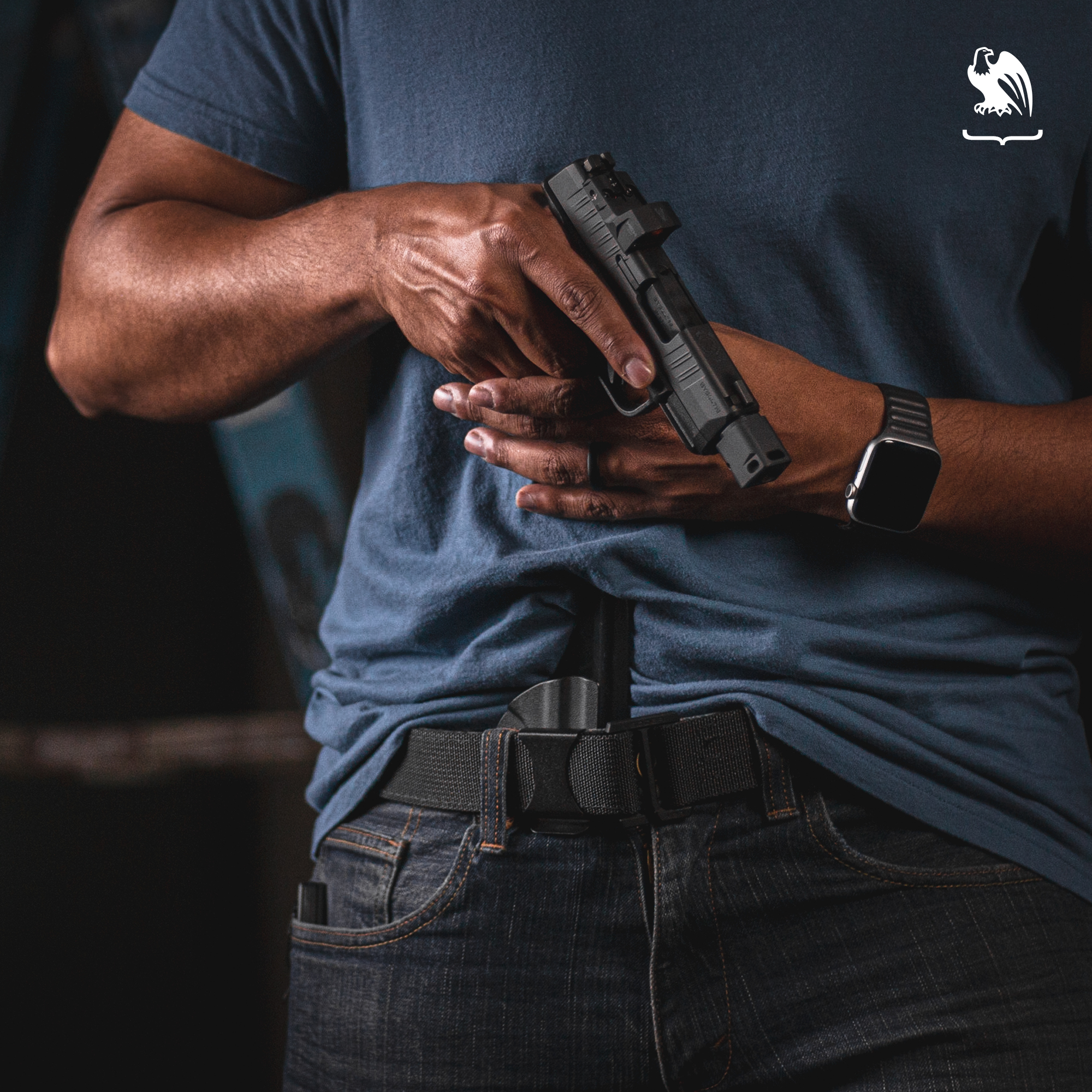
Drawing from inside the waistband is very similar to drawing from outside the waistband. The main difference between the two is when you carry IWB, you now have the added barrier of clothing between you and your gun.
The first line of business is getting into a proper stance. Provectus Group firearms instructor Ken Scott stresses the importance of getting into a good stance, whether that be isosceles, with your feet shoulder-width apart facing forward, weaver, with your weak foot slightly in front of your body, and your dominant foot behind in a boxing stance, or any other position you’re comfortable in, in a Smith & Wesson YouTube video.
“We have to start out with a really good stance,” he said. “The stance is the foundation of everything that we do.”
Next, you have to get your shirt out of the way so you can access your gun. Some experts recommend using your weak hand to pull your shirt up just high enough to grab your pistol with your dominant hand. Other experts, like Nemetz, however, recommend learning how to use your dominant hand to pull your shirt up AND grab your weapon so that your weak hand is free to block an attacker, hold on to something, or anything else it may be needed for.
To draw, grip your gun firmly and pull it out from your IWB holster. Your grip should be positioned so that you don’t have to readjust to shoot. Be sure that the muzzle of your firearm never crosses over any part of your body as you pull it out of the holster.
Use the smallest possible arc to bring your pistol in front of your body and into your firing stance. Scott recommends that instead of drawing your gun and raising it into position via a straight line, you should use a more drastic angle that’s closer to your body to get into position.
“I like to come and take a more drastic angle so I can get the sights to my line of sight. Basically, from here, I can press an accurate shot, but it’s also giving me more time on my sights … and by the time I’m fully pressed out, I have an accurate shot,” he said.
To reholster, follow the same small arc used to draw and snap your gun back into place, again taking care not to point the muzzle toward yourself or anyone else.
Once you have an idea of how to draw your weapon, it’s critical to practice it consistently so that it becomes second nature.
To practice drawing IWB, start with an unloaded gun. Holster your pistol and slip it securely into your preferred concealed carry position. Draw your firearm and note any snags or hangups you run into. If drawing your gun is difficult, you may need to try a new position or adjust the cant, ride height, or retention of your holster until you can draw without issues.
Choosing The Best IWB Concealed Carry Holster
When it comes to your everyday carry IWB holster, finding one that is comfortable, durable, and safe is essential. If you don’t like the holster you have, you’re a lot less likely to use it, which defeats the purpose of “every day” carry.
There are a few different IWB holsters you can use for concealed carry. Some cloth holsters are designed to be convenient and come without belt clips so you can just stick them into your waistband.
While these kinds of holsters are generally pretty comfortable, they’re typically not recommended as they don’t always stay in place when you draw. They can also be more challenging to reholster since your pants will smoosh the fabric as soon as your gun comes out, assuming your holster even stays in your pants while you draw (we like holster clips for a reason).
Leather holsters are another good choice for IWB as they’re typically comfortable and durable. However, if you don’t have one with a good sweat shield, they can get pretty sticky as the day goes on.
Kydex IWB holsters are designed to be incredibly durable and are sleek enough for easy concealment. For those who find the hard plastic less comfortable, a hybrid holster like Vedder Holster’s RapidTuck™ or ComfortTuck™ might be the best choice as you get the best of both worlds with the comfort of leather and the durability of Kydex.
You should also look for a holster with adjustable cant, retention, and ride height so you can customize your carry to a comfortable position. The Vedder Holsters LightTuck™ is famous for being incredibly comfortable and adjustable, making it the perfect concealed carry holster for any position.
Adjusting Your IWB Holster
Having an adjustable IWB holster can mean the difference between your gun digging into your body all day or sitting snugly against your side.
Cant: Cant is one of the most important holster adjustments there is when it comes to IWB concealed carry.
Holster cant is the angle at which your gun sits in your holster. You can tilt your holster forward or reverse on most holsters. Here at Vedder, our holsters are equipped with 30° of adjustable forward AND reverse cant so you can wear your firearm in a multitude of positions, including the standard 3 – 5 o’clock position, appendix, and cross draw.
Play around with your holster’s cant to see which angle is most comfortable, easiest to draw from, and easiest to conceal for you.
Retention: Having your retention set correctly is essential for concealed carrying. Different shooters like their retention tight, loose, or somewhere in between, depending on how easily they want to draw their weapon.
To determine if you need to adjust your retention, unload and clear your pistol. Try inserting your gun into its holster and then draw it. If you find your firearm slides in and out of the holster too easily, you probably need to tighten the retention. If you feel like you’re putting in more effort than you’d like to, loosen it up a bit.
The Vedder LightTuck’s™ sleek design keeps its retention consistent while you’re wearing it and when you take it off. This allows you to keep your weapon securely holstered while you’re storing it in a safe location and allows you to easily reholster without having to undo your pants every time you want to put your gun back on.
Ride Height: Having a holster with adjustable ride height is essential as it allows you to determine how high your weapon sits on your waistline. Each of our Vedder Holsters IWB holsters features three adjustment levels, allowing you to carry your holster right where you want it.
Dress To Impress Conceal Your IWB Holster
Once you have a good IWB concealed carry holster that you like and you’ve narrowed down your preferred position and adjustments, it’s time to find clothes that successfully conceal your weapon.
The first step in finding clothing for IWB carry is to get pants that are the right size for carrying. If your pants are too big, your holster won’t be secure and may slip around. If your pants are too tight, your holster will press against your body too hard and may rub against your skin, which is super irritating. A general rule of thumb is to find pants that are a size up from what you usually wear. That will provide the right amount of space for your holster to rest against your body comfortably.
Next, you need to find a shirt that will conceal your firearm without printing. Printing is when you can see the outline of your weapon through your clothes, defeating the purpose of “concealed” carrying altogether. This usually means wearing looser shirts with dark coloring to eliminate shadowing.
You can do a few things to make sure you’re not printing before you head out for the day. Once your holster is in position and you have your clothes on, look at yourself from all sides in a mirror to see if you can tell where your holster is.
Raise your arms, reach them in front and beside you, and generally move around to make sure your gun isn’t revealed. Make sure your clothes aren’t snagging on your holster anywhere. Check to make sure your holster is tucked comfortably against your body and isn’t protruding in any weird way.
If your clothes don’t pass any of these checks, you may want to rethink your outfit. If you find no risk of your firearm being revealed, then success!
Do I Need A Gun Belt For IWB Carry?
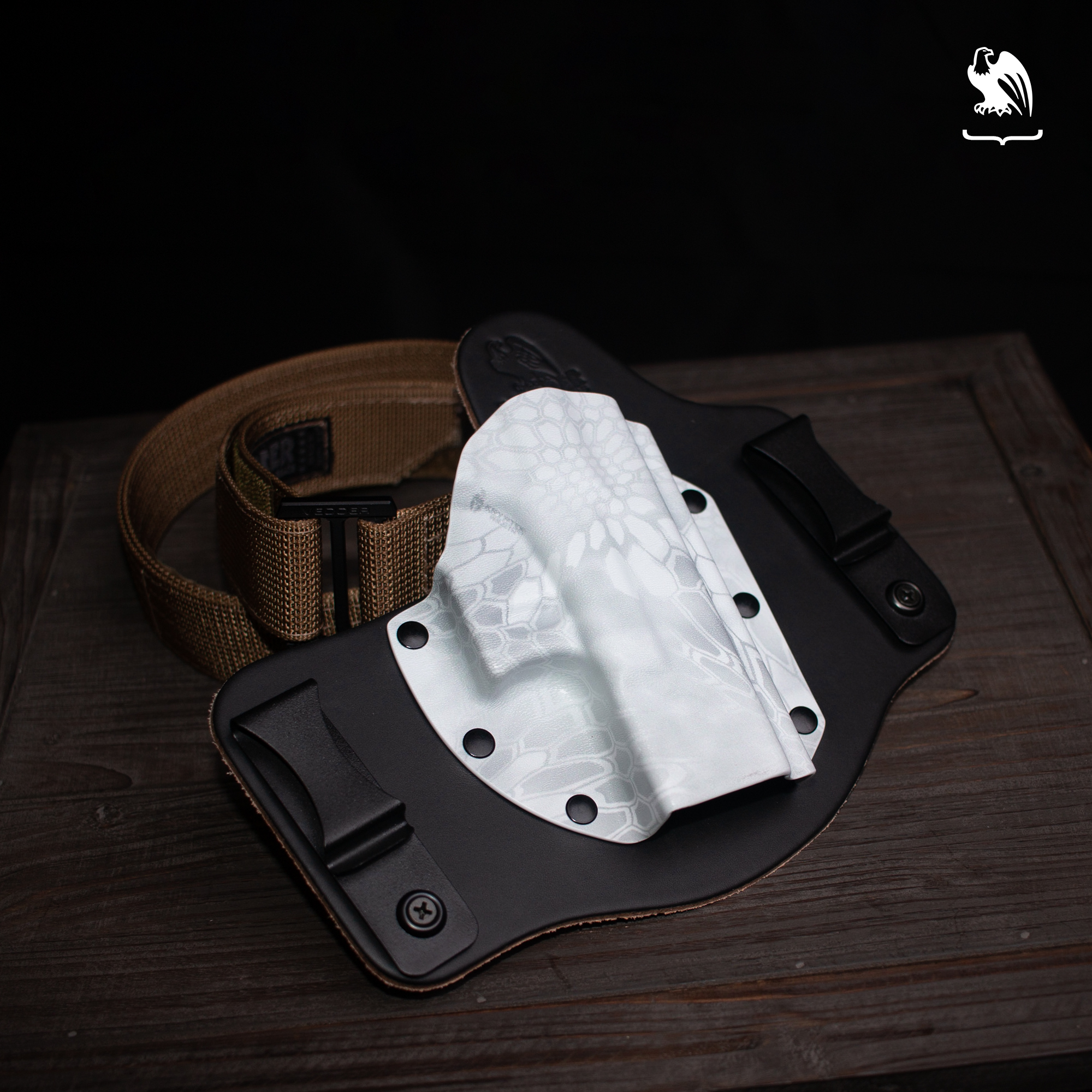
If you’re wondering whether you need a gun belt for IWB carry, the answer is yes.
Sure, you could use a regular belt for carrying IWB. There’s nothing magical about a gun belt that makes it the only kind of belt an IWB holster will clip to. However, regular belts are not designed to support the weight of a firearm, and your pistol will eventually start to sag or slide into an uncomfortable position. This could lead to printing or your weapon not being in the right spot when you need it most.
Concealed carry gun belts, however, are specifically designed to be thicker, stiffer, and more durable. They’re typically made with higher-grade materials that maintain their shape, even after hours of concealed carry.
When choosing a quality gun belt for your concealed carry setup, be sure to consider the following factors:
Stiffness: Your gun belt needs to be strong and stiff enough to hold your pistol and holsters without sagging. Most concealed carry belts are made of high-quality materials to withstand the weight, making them ultra-stiff.
Thickness: If your belt is too thin, your clip could slide around or come off your belt. If it is too thick, your clip will not fit on your belt at all. Your belt should be thick enough to fit your holster clip without it changing positions as you move.
Material: Most gun belts are made of leather or nylon. Leather gun belts, like our Polymer Core Leather Gun Belt, are not your typical belt. They may be extra thick or contain additional materials to increase the stiffness. On the other hand, Nylon belts are typically a thicker, more tactical belt made to withstand the weight of your firearm.
Buckle: There may be various buckle options for a gun belt depending on the material. Leather belts may frequently use a standard style buckle, whereas nylon belts may use a quick-release buckle like our Cobra® Belt or a low profile buckle like our V3 Belt.
For more information about gun belts and how to choose the right one for you, check out our article on the subject here.
What Is A Holster Claw And Should I Use One For IWB Carry?
A holster claw is an IWB holster attachment that can be mounted under your holster’s trigger guard to keep your gun close to your body and help reduce printing. Using the natural curve of your body, the claw presses against your belt to push the grip of your gun back toward you.
While you don’t need a holster claw for IWB carry, it can be a great addition to your carry system.
The most common position people use with a holster claw is appendix carry. However, many of our employees here at Vedder Holsters use our Holster Claw and say it works in almost every position.
For more information about holster claws and how they work, check out our article about these great concealed carry tools here.
Conclusion
Now that you know how to wear an IWB holster and some tips for how to safely and comfortably conceal it, it’s time to figure out what works best for you. Take the time to think about your lifestyle and carry habits, then try out a few techniques to see what you like. Remember, it may take some time to figure out a carry system that works for you!
If you are looking for belts or holsters, check out some of our Vedder Holsters products here. Like everything we sell, our holsters and gun belts are covered by a Lifetime Warranty and a 30-day money-back guarantee.
Looking for items beyond holsters and belts? Check out our Resources Page for popular product links like lights, laser, first aid, maintenance, and more.


